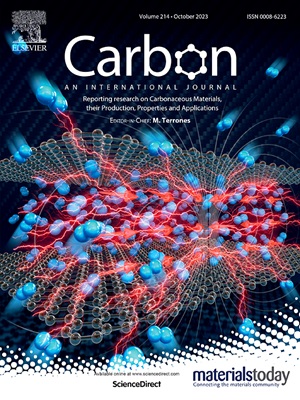3D hierarchically ordered porous carbon frameworks/Co nanoparticles for Broadening electromagnetic wave absorption bandwidth
IF 10.5
2区 材料科学
Q1 CHEMISTRY, PHYSICAL
引用次数: 0
Abstract
With the rapid development of communication technology and the widespread use of high-frequency equipment, electromagnetic interference and irradiation have become increasingly serious, posing risks to human health and the operation of electronic devices. In this work, the 3D hierarchically ordered porous carbon frameworks with magnetic Co nanoparticles (Co–OPCs) are synthesized using the template-assisted method and a pyrolysis process to address these challenges. By adjusting the pyrolysis temperatures, the average size of Co nanoparticles in Co–OPCs ranged from 12.4 to 44.7 nm. The optimal Co–OPCs exhibited stronger electron transfer capability, stronger interface polarization loss of abundant Co/C heterogeneous interfaces, more dipole polarization loss ability from carbon defects and N-doping sites, multiple reflections contributed by the unique hollow structural characteristics and excellent impedance matching degree balanced by dielectric-magnetic loss. Consequently, the optimal Co-OPC sample's minimum reflection loss (RLmin) can reach −43.19 dB at a thickness of 1.70 mm and an effective absorption bandwidth (EAB) up to 6.86 GHz at a thickness of 2.00 mm. This work aims to clarify the electromagnetic loss mechanism of 3D hierarchically ordered porous carbon framework with magnetic nanoparticles and provide an effective method for designing and manufacturing lightweight, high-performance carbon-based absorbers.

求助全文
约1分钟内获得全文
求助全文
来源期刊

Carbon
工程技术-材料科学:综合
CiteScore
20.80
自引率
7.30%
发文量
0
审稿时长
23 days
期刊介绍:
The journal Carbon is an international multidisciplinary forum for communicating scientific advances in the field of carbon materials. It reports new findings related to the formation, structure, properties, behaviors, and technological applications of carbons. Carbons are a broad class of ordered or disordered solid phases composed primarily of elemental carbon, including but not limited to carbon black, carbon fibers and filaments, carbon nanotubes, diamond and diamond-like carbon, fullerenes, glassy carbon, graphite, graphene, graphene-oxide, porous carbons, pyrolytic carbon, and other sp2 and non-sp2 hybridized carbon systems. Carbon is the companion title to the open access journal Carbon Trends. Relevant application areas for carbon materials include biology and medicine, catalysis, electronic, optoelectronic, spintronic, high-frequency, and photonic devices, energy storage and conversion systems, environmental applications and water treatment, smart materials and systems, and structural and thermal applications.
 求助内容:
求助内容: 应助结果提醒方式:
应助结果提醒方式:


